Accidental Rules #6 – Accidentals and Key Signatures
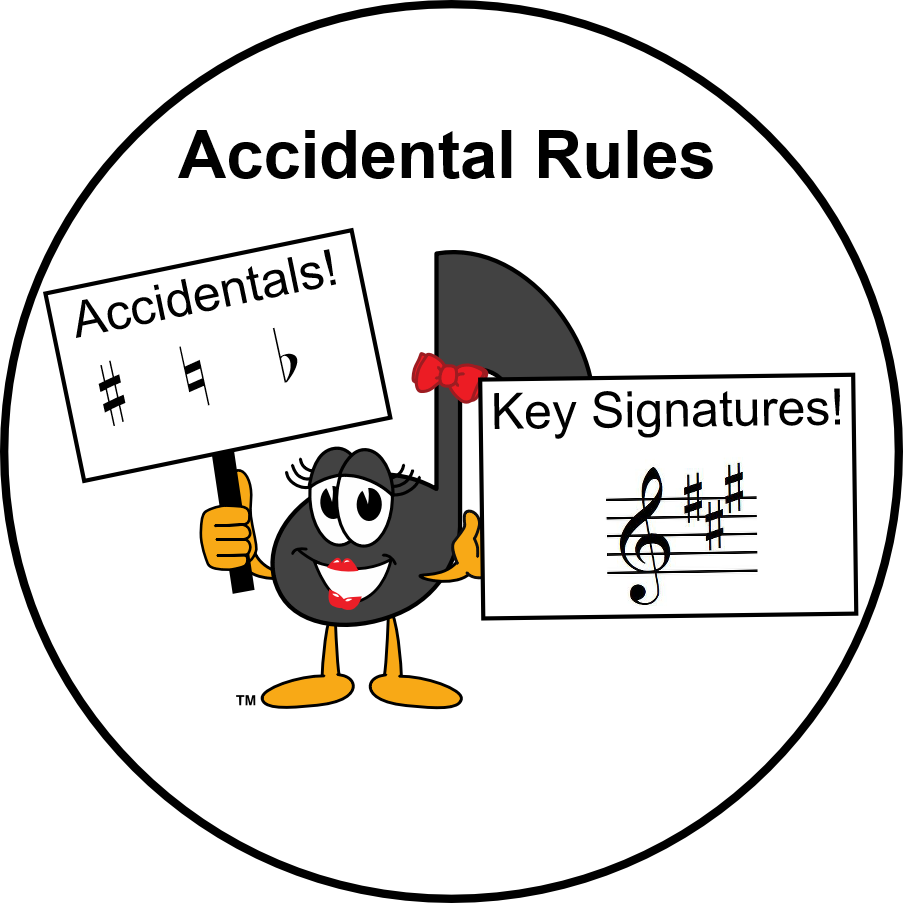
According to the "Essential Dictionary of Music Notation" (published by Alfred Publishing), an Accidental is a "Temporary alteration to the pitch of a note". There are 5 Accidental Symbols - the Double Flat sign, the Flat sign, the Natural sign, the Sharp Sign and the Double Sharp sign.
The Dictionary also states: "When these symbols are used in the music, apart from use in the Key Signature, these Symbols are called Accidentals".
When these symbols are found at the beginning of each line, they represent the Key Signature. The Sharps or Flats in the Key Signature represent the Major or minor scale (the tonality) of the piece of music.
So, what rules do we have to follow when naming notes with Accidentals and Key Signatures? Let's find out!
Accidental Rules - Accidentals and Key Signatures - What is the Difference?
When naming notes with Accidentals and Key Signatures, we have to be aware that the Accidental Symbol or Sign (the sharp, flat, etc.) has different rules when it is:
- found at the beginning of each line of music in the "Key Signature";
- found in the music itself (and is not a part of the Key Signature).
Let's play "Spot the Boo-Boo"! Spot the Dog wants to know if all the notes that are affected by an accidental have been circled in this example? What are your thoughts?
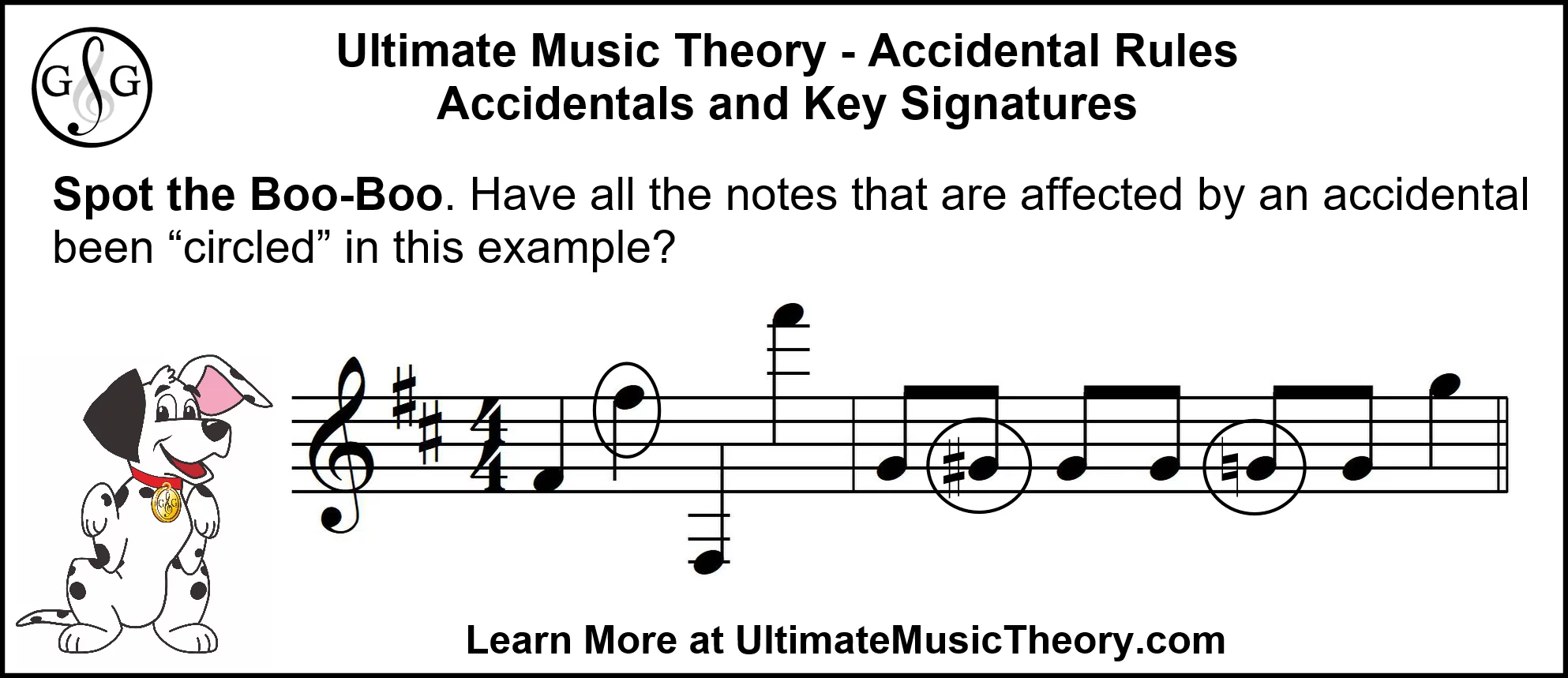
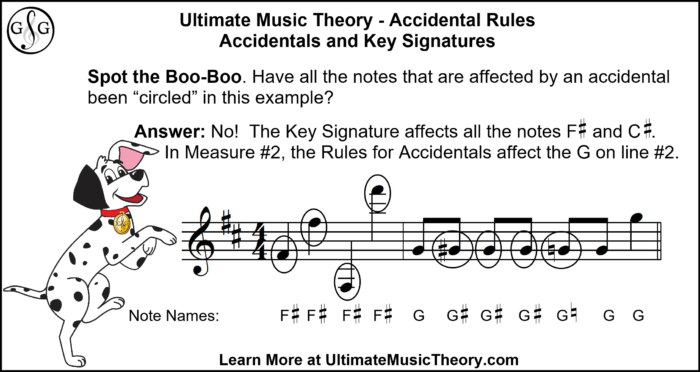
Here we see the Correct answer.
There are rules that affect the accidentals found in the Key Signature. Then there are also rules that affect the accidentals found within the music.
This can be a confusing concept to understand. Please check out the other Blogs in this Series:
- Natural Rules - the "How, Where and When" of the Natural Sign.
- Writing Accidentals - how to write Accidentals using the KISS Method.
- Tied Notes with Accidentals - how a Tie affects notes with Accidentals.
- Naming Notes - how Accidentals affect naming notes.
This Blog will look at ways we can support our Students in learning how Accidentals are part of the Key Signature and how they can also be found within the music.
When I introduce Students to this concept, I start by presenting them with a piece of music that has Accidentals and Key Signatures. I then ask my Students to:
- Identify the Key Signature (the Major or minor tonality).
- Name the Sharps or Flats in the Key Signature.
- Point to notes within the music that are affected by the Sharps or Flats in the Key Signature.
- Identify different accidentals (a separate sharp, flat, etc.) that are found within the music, and discuss what notes are affected by those accidental.
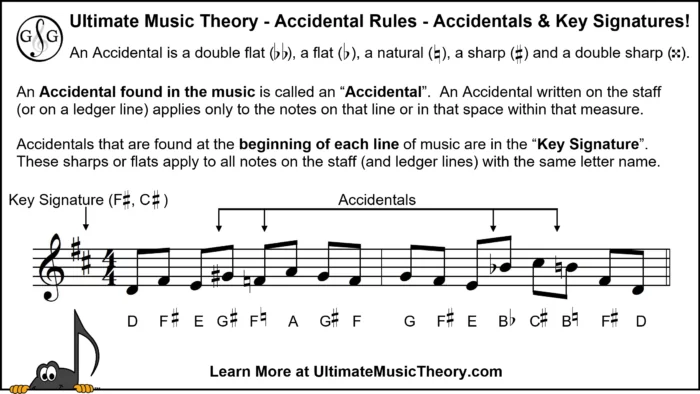
I have found that it is important to remind students that, if there is an F Sharp in the Key Signature, it applies to every single F anywhere on the Staff - and that includes Ledger Lines. An Accidental only applies to the notes on that line or in that space within that measure.
Accidental Rules - Accidentals and Key Signatures
When there is an F sharp and a C sharp in the Key Signature, every single F and C in the music is played as a sharp (unless it is temporarily canceled). It doesn't matter what Clef Sign or if the note is written on the Staff itself or using 20 Ledger Lines, the accidental in the Key Signature affects every single F and C!
In the Example, we have a Double Sharp on the first C in Measure #2. Notice that this Double Sharp written in Space #2 of the Bass Staff only affects the other C written in Space #2 of the Bass Staff in Measure #2 only.
The Accidental written in the music will only affect the note/notes on that line or in that space up until cancelled by the Bar Line or by another Accidental.
A Key Signature Accidental (a sharp or flat in the Key Signature) can be temporarily affected by another Accidental.
Students should review that:
- an accidental in the Key Signature affects every single note with that name anywhere on the Staff (including Ledger Lines).
- an accidental in the Music/Measure only affects a note written on that line or in that space within that measure.
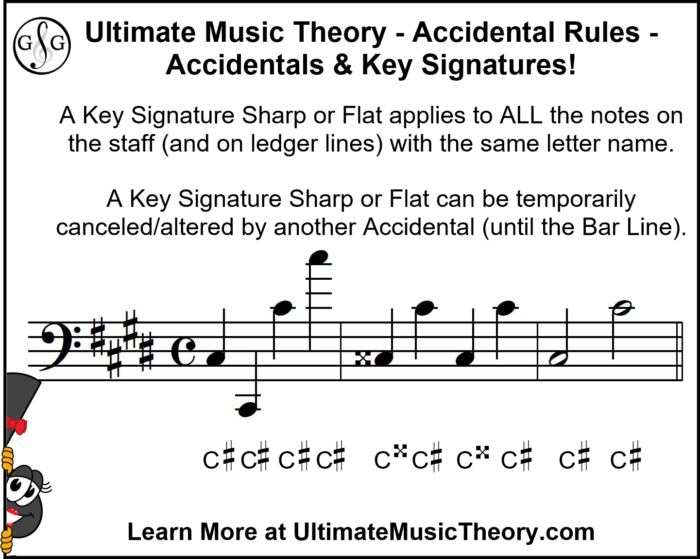
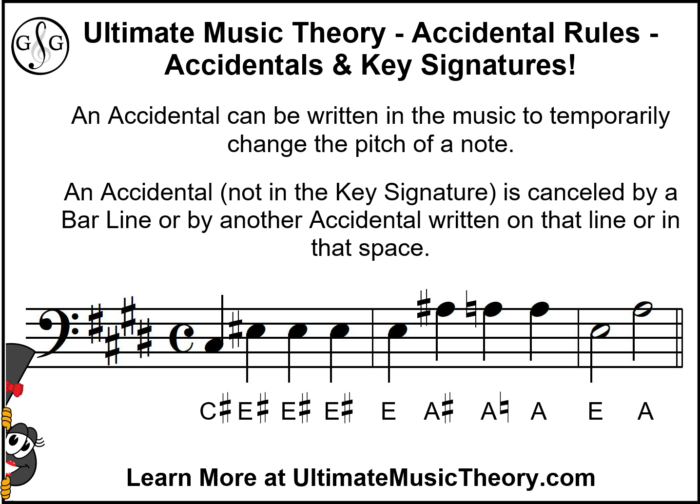
Accidental Rules - Accidentals and Key Signatures
So, what happens when we have an accidental in the music, but that accidental is not a part of the Key Signature?
*Sigh* - Yes, Accidentals are written in the Key Signature and they are also written on notes within the music.
The key point that Students must understand is that an Accidental written in the music is a temporary change for the note!
In Measure 1, the Sharp on Space #3 affects every E written after it appears on Beat #2. We do not need to write a sharp in front of the Es on Beats #3 & #4. They have been affected by the Space #3 Sharp on Beat #2.
In Measure 2, the first Space #3 E is now simply "E". It is not called E Natural, nor does it need a natural sign to cancel the Sharp in Measure 1.
When that Bar Line is written at the end of the measure, it erases any and all of these temporary Accidentals within that measure. I love how easily Bar Lines get rid of those temporary accidentals.
Accidental Rules - Accidentals and Key Signatures - Pop Quiz Time!
Let's have some fun. Take a look at the Pop Quiz below.
When we circle a note that is affected by an Accidental, that Accidental can be
- a part of the Key Signature;
- a temporary change of pitch on a specific line or space.
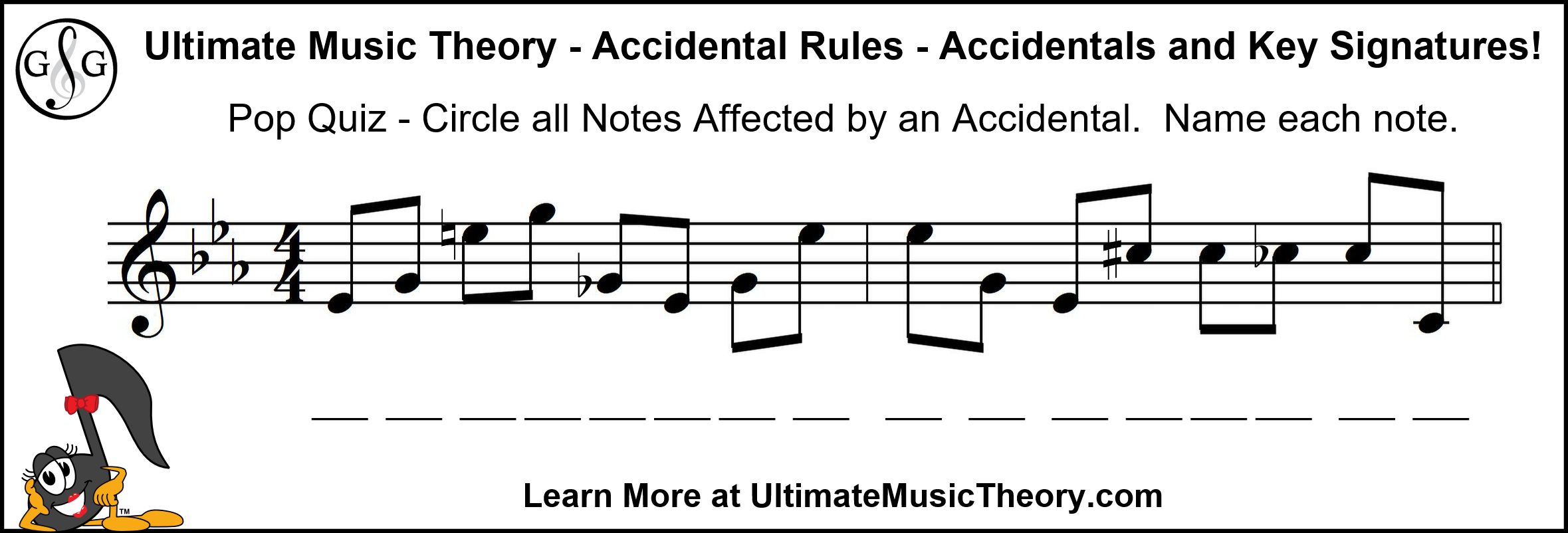
Sometimes I feel like I should be called the "Queen of Doubt". I often second guess myself when I have to think quickly. If, like me, you question whether you are 100% positive of the correct answers to this Pop Quiz, I encourage you to become a UMT Member today.
You will also get 2 extra Worksheets (with matching answers) that match this blog:
- Worksheet - Circle the Notes. By circling the notes, Students can see what notes are affected by the Key Signature and by any Accidentals.
- Worksheet - Naming Notes. Reviewing the placement of the Accidental when naming the notes is very important!
Accidental Rules - Accidentals and Key Signatures - Pop Quiz Answers.
Here are the Answers to our Pop Quiz. How did you do?
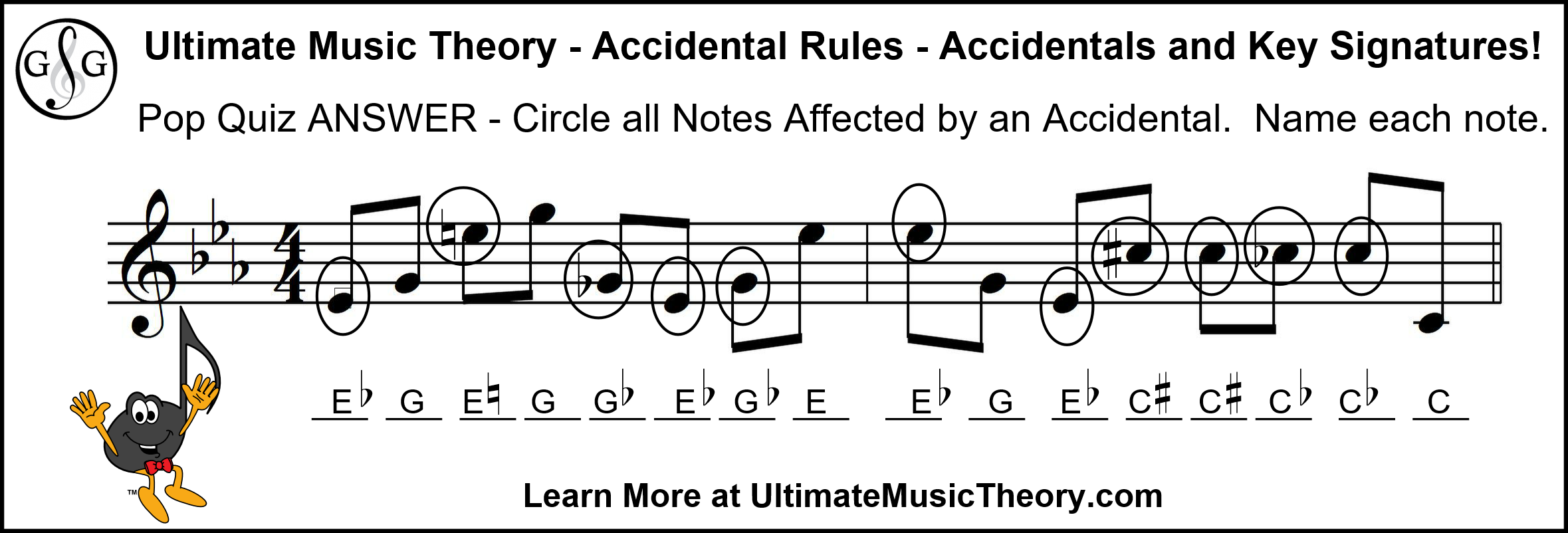

UMT Teachers Membership
♪ LEARN ♪ PLAN ♪ TEACH ♪ GROW
The One & ONLY Ultimate Music Teachers Membership
To Become A UMT PRO!
Your Success Path Starts Here - Join Today!
Keep on Learning... With a Smile and a Song!
Shelagh McKibbon-U'Ren


It is refreshing to find explanations in such an easy format. I taght music for years and even though I wrote the explanations using very simple words, I had a hard time making the students understand. Most of the yime I had to translate the lessons into Spanish for them to understand. The good thing was that I was proficient in music in Spanish. What term I didn’t know I would look up.
Thanks for the explanations
I am wondering if an accidental change will affect both treble and bass within the measure in every situation or could that vary with the composer?
What a great question! And I cannot find a “definitive” answer. I would recommend using a courtesy accidental on the note repeated at the same pitch but using a different clef sign within the measure. This way, there are no questions as to the pitch of the note. Thus, I agree – it will probably vary with the Composer. (I would argue for it being correct with or without the courtesy accidental!) Shelagh
In passages like these, I would use •far• more courtesy accidentals, especially if a key signature is operant.
Agreed. I would too even though we theoretically do not “have” to use them. We must both be “courteous people”! (LOL)
Shelagh
Accidental changes normally apply •only• to the clef/staff in which they occur. Again: courtesy accidentals everywhere else would be called for.
I am a big fan of courtesy accidentals but they are not “required” accidentals. They are there to help make it easier for the person reading the music. If they are not there, it does not mean that it is incorrect. It is certainly nicer to use them!
Shelagh